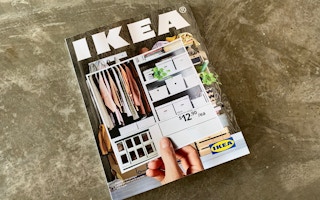IKEA, the homeware giant as famous for its Scandinavian devotion to sustainability as for flat-packed furniture and Swedish meatballs, has been receiving complaints from consumers in Southeast Asia about the unsolicited mailing of the company’s iconic product catalogues.
Why, some are asking, is a company lauded for sustainability initiatives such as solar panels on its buildings, plans for a zero-emissions delivery fleet, and a revamped vegetarian version of its famous meatballs, sending customers paper catalogues they did not ask for?
IKEA Southeast Asia corporate communication head Corinna Schuler told Eco-Business that its annual catalogue—which has been printed since 1951 and is believed to be as widely distributed globally as the Bible or the Quran—is liked by customers who use it as an interior design magazine and a source of inspiration when planning their homes throughout the year.
“It adds a humanistic element to our communication and the printed version has strength as a slower, more mindful medium that resonates well with many who are close to IKEA,” said Schuler.
A waste of resources?
IKEA catalogues are mass-mailed and widely distributed, in Singapore through a deal with Singapore Post, which manages customer data.
One customer in Singapore, who preferred to remain anonymous, has complained twice to IKEA about receiving the 366 gram (he weighed it) catalogue.
After the first complaint made in September 2019, the response from customer service was: “We will acknowledge this matter to the relevant department for their further action and improvement.”
When he received the catalogue again in February 2020, the customer complained again, telling IKEA that the unsolicited mailing was a “totally useless waste of resources”, particularly since he uses the internet to search the company’s product list. He said he would stop buying IKEA products if he received the catalogue again.
Customer service responded by suggesting that the customer contact Singapore Post (SingPost) to ask to be removed from their advertising list.
Another customer in Singapore, who also withheld their name, said: “The terms and conditions of IKEA Family membership don’t mention the catalogue. Maybe they see it as a member benefit—but we dont want it!”
One member of the Journey to Zero Waste Singapore Facebook group responded to a post on the matter as follows: “A true waste of paper, ink, energy and costs on their [IKEA’s] end. They should send it to people who opt-in for it only.”
Another posted: “There has to be a national effort to stop unsolicited hardcopy marketing materials like for [the] DNC registry.”
Singapore’s Do Not Call (DNC) registry covers telemarketing messages via phone call, text message or fax, but does not apply to hardcopy marketing materials. To stop receiving unsolicited marketing mailers, Singapore residents need to fill in a customer service form on SingPost’s website.
IKEA’s spokesperson told Eco-Business that the company plans to make it easy for its loyalty programme members to remove themselves from mailing lists directly through its IKEA Family members portal, and that option is likely to be available later in the year.
She added that the company, using environmental data from pulp and paper production, printing processes and transport, has reduced the carbon footprint of its catalogues from 1.09 kg of carbon dioxide per copy in 2016 to 0.76 kg per copy this year, which she said is comparable to the carbon footprint of four IKEA meatballs.
“We are continually reducing that footprint by selecting suppliers that use mainly renewable energy in their operations, optimising our transport and distribution networks, using uncoated and semi-coated paper and reducing the number of pages,” said Schuler.
Schuler did not provide information on the volume of paper used in its catalogues in Southeast Asia—where it has eight stores as well as e-commerce sites in Singapore, Malaysia and Thailand that generated S$1.2 billion (US$860,000) in revenue in 2019—but said the company uses paper certified by the Forest Stewardship Council (FSC).
All paper suppliers are independently audited “to secure a long-term and sustainable management of forests used in its production,” she noted, adding that the company is aware of its wood suppliers’ locations used to produce the pulp for the paper-making.
Based on the paper recovery levels measured in the 51 countries where IKEA operates, the company estimates that 60 per cent of its catalogues are recycled a year.
In Singapore, however, even if catalogues are deposited in the recycling bins located at the bottom of housing blocks, high contamiation rates of recyclables mean that many will end up in the incinerator.

















